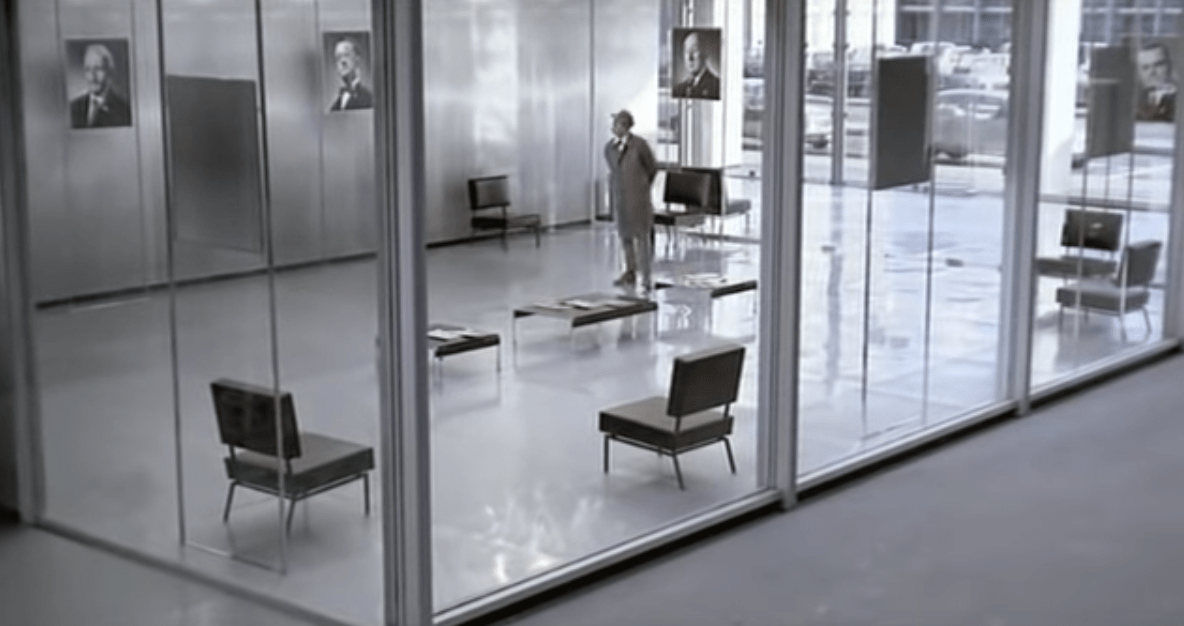
The further south you travel in Italy the more Italian Italians get. People from Milan might as well be French, but go south to Naples, or further to Basilicata, where Il demonio was filmed, and you will find where all the stereotypes come from. The hand gestures, the hot tempers, the garlic, the dark hair and eyes, superstitions, Catholicism, and of course the mafia. The south (Sicily) is where Don Corleone came from.
Southern Italy is not as green as the rest of the country. It’s rocky with sparse, scrubby, vegetation and crumbling cliffs. The landscape plays an integral role in Il demonio. Wide sprawling shots dwarf the characters, isolating them against a harsh landscape where, as peasant farmers, they must struggle to survive.

Often we see the stony little farms and the village from a high or distant vantage point. It is the remote point of view of Purif, the troubled outcast. She hovers like an unwanted crow high above the village looking for a way in.

She’s looking for acceptance, she’s looking for approval but her obsession with a married man and her willingness to indulge in witchcraft to get him ensures that she will always be an outcast. As a portrait of a young woman, Il demonio could simply be about her struggling with mental illness. Almost everything in the film can be explained without appeal to the supernatural, but there are a few things that hint at something more.
Narrative, be it literary or cinematic, can set the terms of what “fiction” means. In relaying a truthful story about the real world we are mostly contained inside a reliable and mutually accepted reality. In fiction, the audience does not necessarily know what kind of universe they are stepping into. We don’t know if magic or spirits exist in this new place. Il Demonio exploits this ambiguity by never fully committing itself to objective reality. The way the movie is filmed makes almost any interpretation possible.
It is a combination of Purif’s erratic behavior including fits of violence, and her admission of dabbling with witchcraft that create an air of menace. The frightened villagers often chase Purif away or try to burn her. Purif may be an outcast but she is not an outsider. She shares all the same beliefs, culture, religion, and ideology of the villagers. She grew up as one of them. In fact, it is only through her being one of them that she can become an outcast. It is only through the rubric of everyone’s belief that she can be a witch. There are critiques of Il demonio that label Purif as a rebel, but she isn’t one. She upholds the same fears and superstitions that all of her peers do. She has an integrated role in the village. She is the monster, the impurity that must be expunged.
It is not a coincidence that she also happens to be young and beautiful. She aggravates the villagers simply by being desirable. She is raped by a priest and later by a shepherd and although little is said about the events it is clear that her beauty and passionate nature are disturbing the peace. To cast her out or burn her would be a means of cleansing the village of its lustful sins.
There is a scene where the villagers gather in a circle in the town square to confess their sins and beg for forgiveness. It is clear that under the oppressive pall of Catholicism, superstition, and family honor these people are stifled, frightened, and disempowered. Burning Purif is an opportunity to exercise agency. The villagers' lives are so restricted by faith, poverty, and tradition. Killing Purif is an opportunity to feel powerful.
Conversely killing Purif is an opportunity to exorcize agency. The hopeless and static life that the villagers are trapped in can be justified if anyone who tries to find a way out fails. Killing Purif proves that trying to escape the bleak state of their lives is futile and allows the villagers to go on believing they are helpless.

Director and writer Bruello Rondi does not provide any of the characters with a way out. The villagers are made to look like an ignorant mob, the priests and nuns are no better, and Purif herself is damned by her own obsessive behavior and willingness to harm others.
When the film works it is a stark and beautiful black-and-white nightmare of mental anguish and ignorant superstition. However, there are scenes where it unfortunately trips over its own intensity and ends up overwrought. To be fair they are all Italian, but even so the drama, the screaming the tearing out of hair stumbles over-the-top at times.
Il demonio was made in 1963 and overwrought or not, it must have terrified audiences. Between the rocky cliffs and the menace of something evil, there is very little to hold onto. Everything takes place in open, empty spaces. Even an attempted exorcism inside a church is held in a giant empty stone room. During the ritual Purif twists and turns like a suffocating fish on the floor and clambers up onto all fours with her back arched and her stomach toward the ceiling. Then she creeps around the church like a dislocated crab. There is little doubt that William Friedkin saw Il domonio before he made The Exorcist two years later in 1973.

As central as Purif is to the film, our window into her mind is limited. She seems undecided about what is happening to her. At times she takes responsibility for choosing witchcraft, other times it seems as though she is possessed. She also seems to at least partially recognize that she is mentally unstable and vulnerable to what people tell her. For her, the whole experience revolves around her unreciprocated love for Antonio, but for the village, it is a battle for the souls of everyone.
The dynamic of the unwanted outsider fits a myriad of possible interpretations. The film could be seen as expressing the old world’s anxiety of having to make way for the new social structures of the modern age.
It could even be about postwar trauma and the deep distrust between neighbors who wondered who was a collaborator and who was in the resistance. The expulsion of a scapegoat lends itself to many ideas.
Brunello Rondi made several films about “rebellious” women. He eventually became a prominent figure in Italian cinema. He was a close friend of Fellini’s and frequently collaborated with him. Brunello wrote the screenplays for 8½ and La Dolce Vita. His experience and craftsmanship are apparent in Il demonio which he both wrote and directed. The end result is a little bit pulpy, but it is still rich. The film is like a Verdi or Puccini opera where everything is desperate and breathless and before you know it you have gone from rolling your eyes to being caught up in the drama.

If you enjoyed this article you might also enjoy —
https://filmofileshideout.com/archives/masumuras-dark-and-bloody-irezumi/



